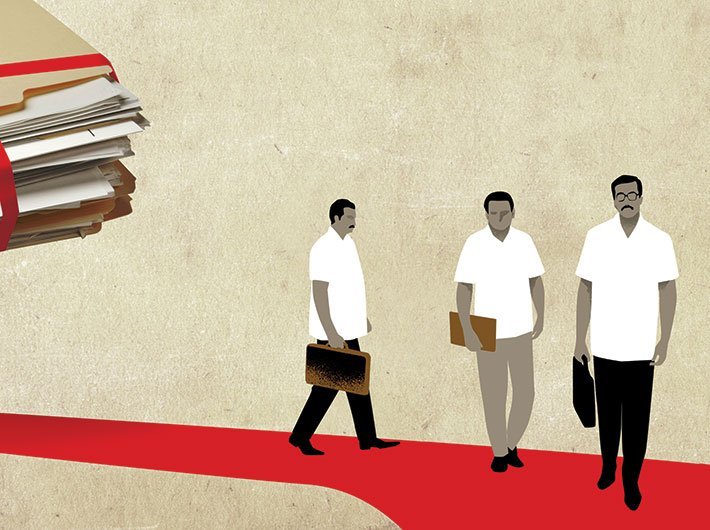The bloated bureaucracy is in desperate need of reforms so that there is minimum government and maximum governance
Uttar Pradesh has been advised by Niti Aayog to trim its bureaucracy to streamline functioning and boost efficiency, a civil service reform initiative that needs to be urgently undertaken across the country.
The Niti Aayog has asked the Yogi Adityanath government to initiate a restructuring of the state government. The Aayog has also offered expertise to help in institutional restructuring which seeks to club departments with overlapping functions and abolish those not needed as an overgrown bureaucracy and a poor culture of governance that make administration difficult in testing times, reported
The Times of India
Prime minister Narendra Modi has repeatedly stressed upon minimum government, maximum governance. But, that cannot happen till such time the pressing issue of too few group A and group B officials and too many group C and group D personnel is not tackled.
The civil services in the country engage a huge work force of about 6.4 million employees at all levels within the state governments and the central government, with the Indian Administrative Officers perched right at the top of the pyramid.
The massive bureaucracy needs a huge amount of taxpayers’ money to maintain, but the perception is that it is bloated. The most common complaint is its frustrating inefficiency.
Compounding the problem is the staff mix, with the group C and group D employees who are not specialists. They dominate the civil service, but do not add value. Those who are specialists are few, with group A staffers being about three percent of the total. ‘Census of Central Government Employees’ 2011
said that about 97% of regular central government employees were non-gazetted. The overall ratio of gazetted to non-gazetted employees was 1:17. In case of ministry of railways, however, this ratio was 1:78.
Amongst regular central government employees, 69% were holding group C posts and 16% were in group d posts. About 12% were holding group B posts whereas employees holding group A posts were only about 3%.
The civil service reforms must focus on addressing the issue of the numbers.
As implausible as it may sound, there is a shortage of IAS and IPS officers in the country. On the one hand, there is an opinion that there are too many civil servants, and on the other hand, there is a need for more. Somewhere in between lays the truth.
There are 4,926 IAS officers as against their total authorised strength of 6,396, leaving a vacancy of 1,470, the Lok Sabha was
informed. The highest number of 128 vacancies are in Bihar, followed by 117 in Uttar Pradesh and 101 in West Bengal.
Parliament was also told earlier this year that the occurrence of vacancies and its filling up is an ongoing process. The government has increased annual intake of IAS officers to 180 and intake of IPS officers to 150 during last four years.
A part of the problem is clear. There are too many group C and D personnel and too few group A and B officials. The policymakers have to address the issue of scaling up the group A and B officials and reducing the group C and D employees.
It won’t be easy to do so. The lopsided system is currently in favour of ‘desk’ jobs, with many pen pushers spending years in one position. India currently needs government employees out in the field, taking care of education and health. But that is not happening.
There is no system in place to redraw the current practices so that the excess staff can be promptly shifted to places where they can be better utilized. Right now, the government is unwieldy and unmanageable.
This is something that the government needs to learn from the private sector, which knows how to best deploy its resources.
The World Bank in an exhaustive report on ‘Civil services reform in India’ in 2001 had gone into the situation in Uttar Pradesh.
“In the period immediately after independence, UP had one of the more effective public administrations. Unfortunately, its performance has eroded significantly, with the decline becoming increasingly pronounced in the 1990s. This deterioration has had significant repercussions for the state's ability to expand its per capita income. It has also interfered with UP's ability to make progress on a host of important social indicators.
“The roots of this decline are many. Chronic political instability and frequent changes in government have placed tremendous demands upon politicians for money and patronage to assure their re-election. These pressures have in tum helped erode the boundary between the political and administrative spheres and contributed to three major problems: large-scale personnel transfers, many of which were motivated by considerations of personal or political loyalty rather than performance; widespread patronage-based recruitment; and the fragmentation and balkanization of administrative structures,” said the World Bank
report
The report also said that transfers are one of the few tools that politicians have for ensuring the responsiveness of the administrative branch. “However, excessive recourse to this instrument has had a debilitating and corrosive effect upon both managerial authority and staff morale. The problem of transfers has become so bad that one senior UP government official recently quipped to the press, ‘the only thing that moves in UP is an officer’”.
Niti Aayog asking UP to trim its bureaucracy is just one example. A lot more needs to be done, before one can confidently say that the civil service is fleet-footed and not obese.
